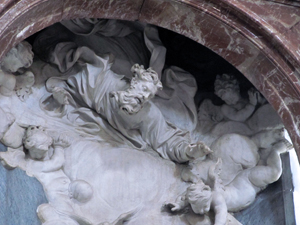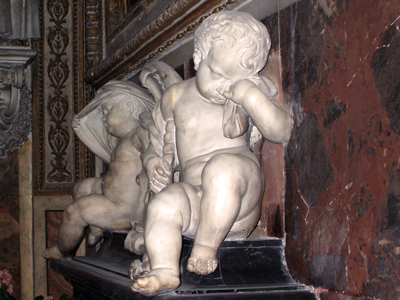SUN AN’ SOUL - DREAM AN’ ROME
SAN GIOVANNI DEI FIORENTINI
 |
| San Giovanni dei Fiorentini, chapel of Altagracia - click to enlarge |
The construction of San Giovanni dei Fiorentini, the national church of the Florentines, was entrusted in 1519 to Jacopo Sansovino, but Jacopo sank into the foundation, because the area where the church was to be built, in the next to the Tiber was sandy and Jacopo failed to lay the foundation.
To resolve the problem it was then called Antonio da Sangallo the Younger (1484 - 1546), who even drew the inside, built, with modifications, by Giacomo Della Porta (1533 - 1602) and completed by Carlo Maderno (1559-1629).
The dome, little loved by the Romans, who called it the "comfit", was made by Carlo Maderno, who completed the work around 1620.
The façade is one of the best work of Alessandro Galilei (1691-1736), a descendant of Galileo Galilei.
The interior, three naves with five chapels on each side, retains with its white walls that purity which enhances the design.
In the right aisle the Firenzuola chapel on the side walls shows two frescoes attributed to Orazio Gentileschi (1563 - 1639), a close friend of Caravaggio. Architecture by Giacomo della Porta.
 |
| Frescoes attributed to Orazio Gentileschi - click to enlarge |
Ferdinando Fuga (1699 - 1781) was responsible for the architecture of the fifth chapel dedicated to St. Filippo Neri. On the pillars in front of the chapel we see the bust of Pope Clement XII Corsini, dated 1750, by Filippo Della Valle.
Before the right transept the tomb of Francesca Calderini was carved by the great Ercole Antonio Raggi in 1655.
In the right transept the Martyrdom of Saints Cosmas and Damian is one of the masterpieces of Salvator Rosa (1615 – 1673), who proud of the work done said: “Come Michelangelo and draws better than me that bare man, I have done”.
On the walls the bust of Ottavio Corsini is owed to the famous Alessandro Algardi (1598 - 1654), and to the no less famous Ercole Ferrata (1610 - 1686) Ottaviano Acciaioli.
The architecture of the chapel of Altagracia is a work of Carlo Maderno, inside an enchanting fresco, attributed to Lippi father (1406 - 1469), or his son Filippino (1457 – 1504).
The Falconieri chapel dedicated to St. John the Baptist was designed by the great Borromini (1599-1607), inside the Baptism of Jesus is one of the masterpieces of Ercole Antonio Raggi (1624 – 1686).
 |
 |
| The Baptism of Jesus - click to enlarge |
In the floor of the nave, between the Falconieri chapel and the Sacchetti chapel,
side by side we see the tomb of Carlo Maderno and that of his nephew Francesco Borromini.
Borromini committed suicide, but it is said that before he died, after an agony of three days, he confessed, that’s why his body is buried in consecrated ground.
Looking up you can admire the pure decoration of the dome.
 |
| San Giovanni dei Fiorentini, the dome - click to enlarge |
To the left is the chapel of the famous Sacchetti family, architecture of Carlo Maderno, at the center of the chapel the bronze crucifix, designed by Prospero Antichi active in Rome from 1578 to 1591, was made by Paul Sanquirico (1565 - 1630).
On the left side of the chapel Giovanni Lanfranco (1581 - 1647), painted the Ascent of Mount Calvary, where we see a touching Madonna and on the right wall, the prayer in the Garden, with an unforgettable Christ.
In the fourth chapel of the left aisle, dedicated to Saint Anthony Abbot, beautiful cherubs, architecture by Giacomo Della Porta, who designed all the chapels of the left aisle.
 |
| The cherubs of S. Anthony Abbot chapel - click to enlarge |
Therefore inside the church worked as architects Giacomo Della Porta, Carlo Maderno, Francesco Borromini and Ferdinando Fuga, in short, the crème de la crème, the best of the best.
Leaving the church turn left on Via Acciaioli, it is the entrance of San Giovanni dei Fiorentini museum. Excellent the sculptural set apart: Michelangelo, Benvenuto Cellini, Bernini, Raggi; interesting furnishings.
back |

